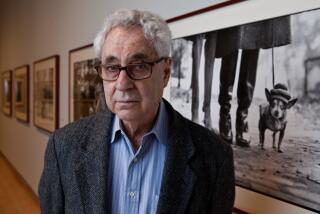Feasting With Stieglitz
- Share via
There is a dinner game in which participants are invited to select a companion from history. Now, 90 years after Camera Notes ceased publication, a conversation with its editor, Alfred Stieglitz, might be entertaining.
Camera Notes, published quarterly from July, 1897 through July, 1903 in editions of 1,000 copies, was the pulpit from which Stieglitz praised amateur photography as a fine art. Through articles and essays written by contributing photographers, art critics and Stieglitz himself, the message was repeated and reinforced: “ . . . the camera, properly guided, is capable of art--real art--there is no longer a doubt.”
Christian Peterson’s new book, “Alfred Stieglitz’s Camera Notes” (The Minneapolis Institute of Arts/W.W. Norton: $39.95; 204 pp.) is more like a weekend retreat than a mere evening with the opinionated editor of “The Official Organ of the Camera Club of N.Y.” Peterson is associate curator of photography at the Minneapolis Institute of Arts. Like a docent, he leads us through careful examinations of the history and politics of the club and its influential publication. His book reproduces all 91 photogravure images from Camera Notes (in half-tones now), and also includes thumbnails of the 267 half-tones that Stieglitz selected to further make his point.
Peterson, chronicling Stieglitz’s philosophic evolution, observes “the necessity of emotion in pictorial photographs . . . (is the) element that distinguishes an artistic print from the factual, everyday photograph so common in the popular press.” To be fine art, photographs must result from subjective responses of their makers to their subjects.
Yet the Camera Club was made up of amateurs not wholly convinced of Stieglitz’s lofty direction. Dissent in the ranks in late 1900 put Stieglitz on the defensive. For the next two years, the narrow minds of the club closed in on him, and in his July, 1902 issue, he resigned.
With a tight group of full-time photographers of better-than-amateur skills, he founded the Photo Secession and a new magazine, Camera Work. With the Photo Secession, photography as art would veer further from the factual everyday image. Over a dinner today, Stieglitz’s observations on contemporary fine art photography and on photo-realist painting would be fascinating.
Peterson prepared this book for the traveling show organized by the Minneapolis Institute of Arts. The show visits Phoenix, June through August, 1994, and Santa Barbara, February through April, 1996. There viewers can see firsthand the pictorial work Alfred Stieglitz propounded. Until then, Christian Peterson’s book is a terrific way to spend a weekend.
More to Read
Sign up for our Book Club newsletter
Get the latest news, events and more from the Los Angeles Times Book Club, and help us get L.A. reading and talking.
You may occasionally receive promotional content from the Los Angeles Times.









